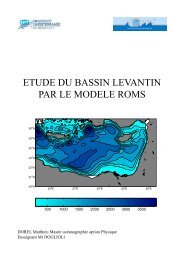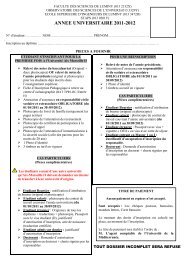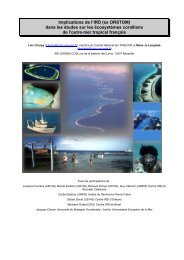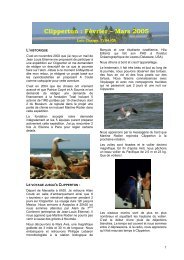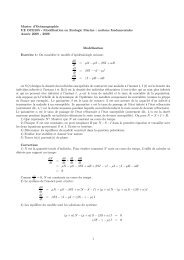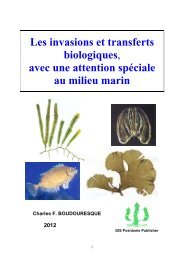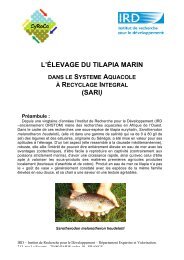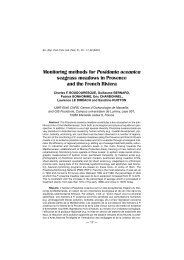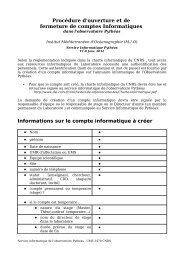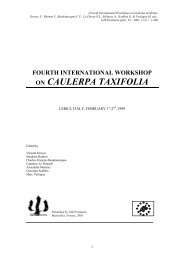Pour en savoir plus - Centre d'Océanologie de Marseille
Pour en savoir plus - Centre d'Océanologie de Marseille
Pour en savoir plus - Centre d'Océanologie de Marseille
Create successful ePaper yourself
Turn your PDF publications into a flip-book with our unique Google optimized e-Paper software.
SUMMARY<br />
This study concerns a shallow aquatic ecosystem, Lake Guiers (S<strong>en</strong>egal) which the main<br />
vocation is the distribution of tap water for Dakar City (30%). The main objectifs were to<br />
un<strong>de</strong>rstand the factors susceptible to control the <strong>de</strong>velopm<strong>en</strong>t of the differ<strong>en</strong>t<br />
phytoplankton species, and particularly the cyanobacteria <strong>de</strong>veloping in the lake since the<br />
operating of hydraulic dams in the 80s on the S<strong>en</strong>egal River.<br />
The phytoplankton was analyzed during (1) an annual cycle from march 2002 to february<br />
2003 in the c<strong>en</strong>tral zone of the lake (4 repres<strong>en</strong>tative stations) and (2) a north-south spatial<br />
approach with 10 sampled stations to study the heterog<strong>en</strong>eity if the lake.<br />
The evolution of the phytoplanktonic community (taxonomy, species richness, diversity<br />
in<strong>de</strong>x, abundance and biovolume) as well as its interactions with the other compon<strong>en</strong>ts of<br />
the ecosystem (17 <strong>en</strong>vironm<strong>en</strong>tal variables among which temperature and wind; 18<br />
biological parameters including zooplankton) were studied using multivariate analyses.<br />
Among the 111 species listed during the study, 24 are dominant constituting 11 functional<br />
groups according to Reynolds et al.’s classification (2002). Three species form the bulk of<br />
the phytoplankton community: two cyanobacteria (Cylindrospermopsis raciborskii and<br />
Lyngbya versicolor) and a bacillariophyceae (Fragilaria sp.).<br />
Experim<strong>en</strong>ts allowed to estimate the growth rates of one of the pot<strong>en</strong>tially toxic<br />
cyanobacteria, Cylindrospermopsis raciborskii, as well as the impact of the grazing exerted by<br />
the zooplankton on this dominant species.<br />
We observed a clear alternation betwe<strong>en</strong> the cyanobacteria dominance (July-October)<br />
(temperature averages of 29,5°C) un<strong>de</strong>r dominant winds (maritime tra<strong>de</strong> winds)<br />
explaining the water column stability and the diatom dominance in response to the flood<br />
and the change of wind direction (contin<strong>en</strong>tal tra<strong>de</strong> winds).<br />
Toxicity tests performed on the strains of C. raciborskii isolated from the lake were all<br />
negative. However, a perman<strong>en</strong>t survey should usefully be established on Lake Guiers to<br />
follow water quality and healthiness, and prev<strong>en</strong>t future possible toxicity ev<strong>en</strong>ts in these<br />
multi-purpose aquatic reservoirs which t<strong>en</strong>d to become wi<strong>de</strong>spread in the tropical zones.<br />
Keywords : phytoplankton, cyanobacteria, bottom-up and top-down factors, Lake Guiers,<br />
S<strong>en</strong>egal.<br />
11



